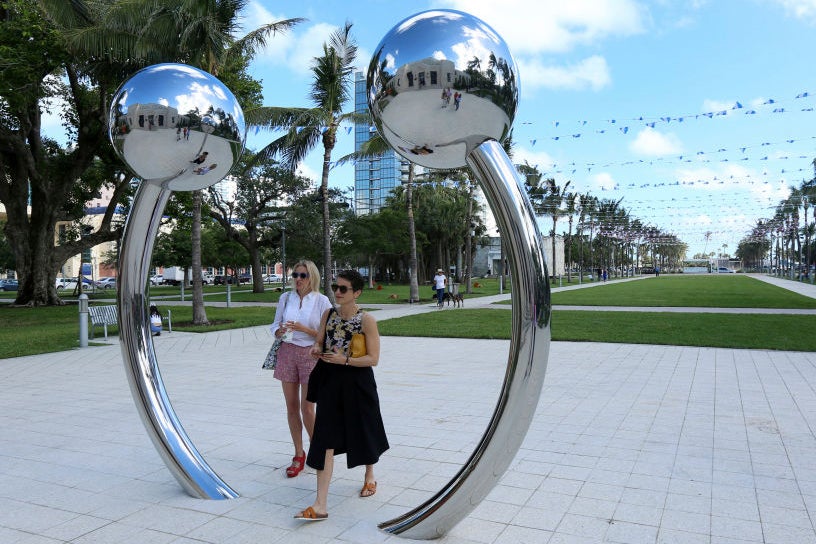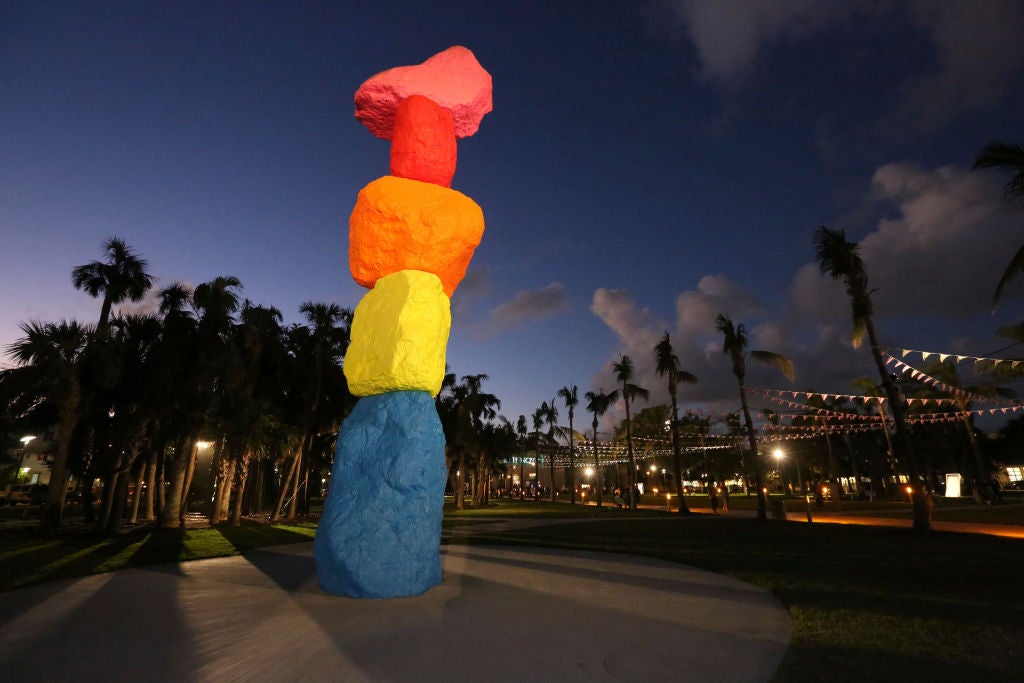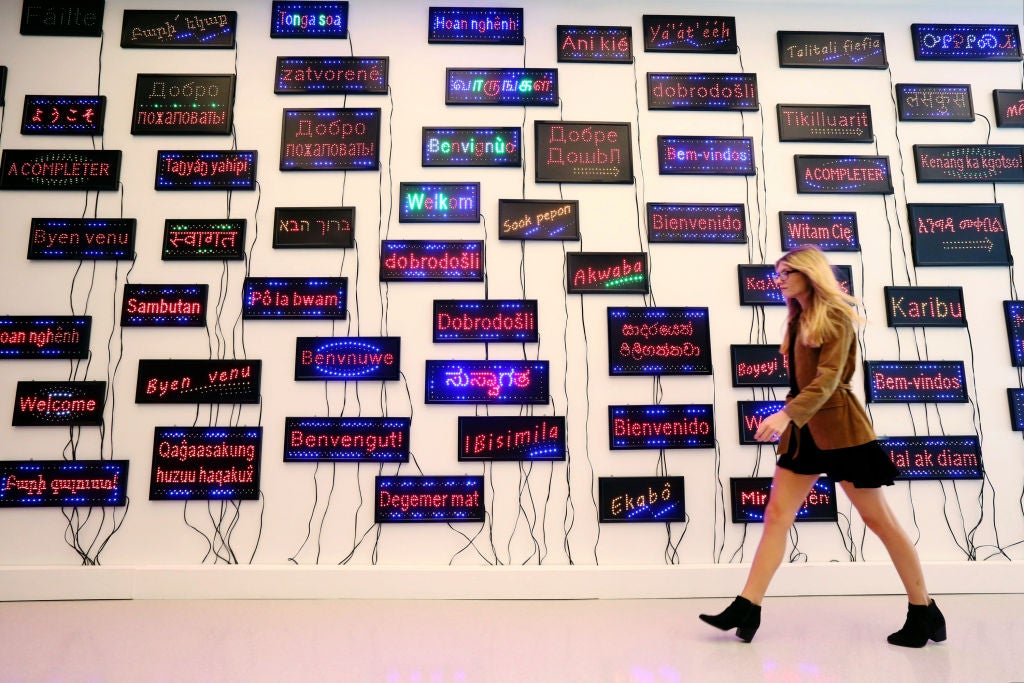Post-Irma, Art Basel at Miami Beach is still swinging
Among the finds, Brazilian galleries. At the top of their game: Wolfgang Tillmans, Carrie Mae Weems and Ugo Rondinone

This year’s edition of Art Basel at Miami Beach, America’s premier contemporary art entrepot and air-kissing arena, was always bound to take place against a backdrop of construction. This city, after all, loves real estate as much as it does art, and two museums – the veteran Bass Museum and the new Institute of Contemporary Art – have spiffy new homes to show off. The fair itself has new digs too, or at least refreshed ones: The hulking Convention Centre, a few blocks from the Atlantic and home to some 250 galleries, is in the midst of a long-overdue refresher, its faded art deco facade re-clad with dark glass.
But Miami Beach’s recovery from Hurricane Irma, which slammed into this low-lying resort city in September and turned the main thoroughfare of Collins Avenue into a waterway, has occasioned its own round of reconstruction. The major museums here were spared a direct hit, but numerous local artists whose studios or warehouses flooded have had to apply for emergency relief. The hurricane also delayed renovations to the Convention Centre, whose adjacent streets are still ringed by barriers and tarpaulins. And several seaside properties remain closed, including the Raleigh Hotel, my regular spot for a pre-fair cortadito for a decade now.
But Art Basel is still swinging, and the gang’s all here: Collectors from the United States and Latin America, young artists on the make, star museum curators escorting chequebook-toting board members and propulsive dealers jogging along the beach at 6 am after nights on the tiles. The event can sometimes feel like its very own art bubble, and during Wednesday’s VIP preview of the 16th edition of this warm-weather cousin of the long-running Swiss art fair, even the revelation of the Saudi buyer of Leonardo da Vinci’s Salvator Mundi took a back seat to cooing about the new floor layout, grousing about the traffic and laughing about a dispute with the local fire department that left many powerful dealers locked out of the fair’s opening.

Among the galleries at Art Basel Miami Beach, which runs through Sunday, you will find, as always, a mix of blue-chip trophies, rising talents, cheesy selfie backdrops and genuine discoveries (especially at Mexican and Brazilian galleries, which reliably offer the most insights to US audiences). A number of significant artists appear at three, four or more galleries here. With diligence and a very large bank account, you could walk out of here with your own personal retrospective of the vital and challenging German painter Albert Oehlen: The Berlin dealer Max Hetzler is showing a syncopated abstraction of browns and yellows from 1990, while Edward Tyler Nahem of New York has a rowdier, stained work from 2005, and Corbett vs Dempsey, from Chicago, features one of his recent, more composed Tree paintings.
Wolfgang Tillmans, the sensitive, London-based German photographer, is also represented across the fair, from David Zwirner, which is showing a large-scale 2013 portrait of a young man whose hair and sweater are flecked with snow, to the Los Angeles gallery Regen Projects, with a knockout new seascape, whose wide expanses and dramatic clouds recall the 19th-century photographs of Gustave Le Gray.
Tillmans is a photographer at the top of his game, as is Carrie Mae Weems, who recently completed an intriguingly melancholy 25-piece composition that pictures the R’n’B singer Mary J Blige in poses you can read as proud, vulnerable, accomplished and resigned. The photographs in this series, titled The Blues, on view at the booth of the Jack Shainman Gallery of New York, are tinted the titular colour, which allows Weems to short-circuit photographic stereotypes of African-Americans, but also freights her pictures of Blige with inescapable sadness.
Among younger talents, I was impressed by a pair of delicate but unsettling paintings on rice paper by the Iranian artist Shahpour Pouyan, at the booth of the Galerie Nathalie Obadia, based in both Paris and Brussels. Pouyan has reproduced centuries-old Persian miniatures that depicted Muhammad and other religious figures – Central Asian artists, unlike their Arab counterparts, frequently portrayed the prophet in art – but has excised the figures to leave only gold arches, blue backdrops and flowing calligraphy. The erasure is at once a tribute to the less heralded constituent elements of Persian painting and fearsome metaphor for recent attacks on religious representation, from the museums of Baghdad to the newsroom of Charlie Hebdo.

But I often find Art Basel Miami Beach more valuable for historical surprises. Galeria Jaqueline Martins, one of Sao Paulo’s sharpest, has a solo presentation of the Brazilian feminist and visual artist Leticia Parente (1930-1991), who grafted together street plans of Salvador, Fortaleza and Rio de Janeiro into personal memory maps or who filmed herself applying makeup in the bathroom while her mouth and eyes were taped shut. (Parente is also a standout of Radical Women, the history-rewriting showcase of female Latin American artists up now at the Hammer Museum in Los Angeles and coming to the Brooklyn Museum in April.)
And the can’t-miss booth of this fair comes from a gallery that, I’m embarrassed to say, I’d never heard of before: Applicat-Prazan, a decades-old Parisian space participating in Art Basel Miami Beach for the first time. This specialist in mid-century European painting has arrived with a dozen bracing works by figures too little known in the United States, including Otto Freundlich, Nicolas de Stael and Hans Hartung. A seething 1960 abstraction by Karel Appel features thickly applied splashes of white and brown paint, whose seeming carelessness belies clear care. In Jean Helion’s Trois Nus et le Gisant (Three Nudes and Reclining Man), a disquieting painting from 1950, three women – the Fates, or just an artist’s models? – sit in judgment over a splayed young man, perhaps in post-coital slumber, perhaps murdered.
This week also featured the opening of a permanent home in the Design District for the Institute of Contemporary Art, Miami, which was founded in 2014 after a turbulent split with another museum. The Spanish firm Aranguren & Gallegos Arquitecto has fitted the three-story building with a facade of shiny metal panels and cutout triangular windows: very un-deco, very new Miami. Commendably, the institute has free admission, although in these initial days, it is encouraging visitors to book time slots online.
Alex Gartenfeld, its deputy director and an astute curator who has stuck with the museum through the last years’ ructions, has organised its inaugural show: The Everywhere Studio, a ramble through recent art and economic history that examines how artists’ workspaces have shaped their production. The isolation of the studio in art from the 1960s and 1970s – including Bruce Nauman’s and Hanne Darboven’s conceptual documentations of everyday life in the studio, and an excellent self-portrait at work by Jorg Immendorff – feels very different from Neil Beloufa’s and Yuri Pattison’s studio scenes from the neoliberal present, when work and free time have collapsed into each other.
But the show is badly overhung, with more than 100 works, not all memorable, in too little space. I suspect that Gartenfeld, who is at work on next year’s New Museum Triennial in New York, will need time to learn what the spaces of the new institute can do: There is good thinking here, and an impressive catalogue, but The Everywhere Studio needs to be de-cluttered.
Back by the beach, the Bass has completed its transformation by the architects David Gauld and Arata Isozaki; the museum now has 50 per cent more space on the same footprint, helped by the removal of cumbersome ramps that led visitors upstairs. In three inaugural solo shows, Mika Rottenberg is presenting a new video that takes her uncanny, dream-logic visions of factory work to the US-Mexico border, while Pascale Marthine Tayou has disrupted the Bass’s permanent European wing with new African masks that evoke mass tourism and global trade.
But it’s the Swiss artist Ugo Rondinone who steals the show with a walk-in installation, hilarious and grim by turns, consisting of 45 full-size mannequins of clowns, seated on the gallery floor with expressions of boredom and fatigue. After a few days at the fair, the metaphor of the exhausted clown is all too apt.
© New York Times
Join our commenting forum
Join thought-provoking conversations, follow other Independent readers and see their replies
Comments
Bookmark popover
Removed from bookmarks